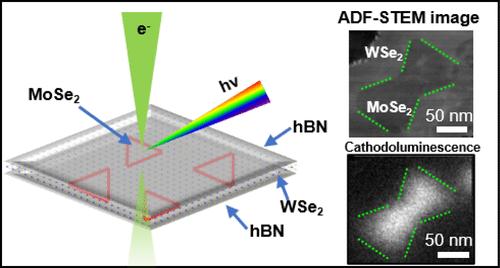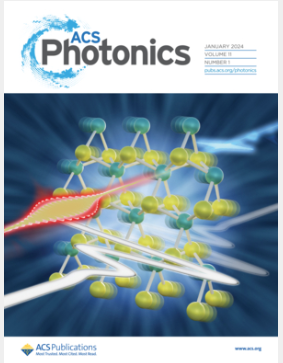二维量子受限发光
IF 6.5
1区 物理与天体物理
Q1 MATERIALS SCIENCE, MULTIDISCIPLINARY
引用次数: 0
摘要
从嵌入在另一层二维过渡金属二硫化物(TMDs)基体中的单层二维过渡金属二硫化物(TMDs)中实现局域发光已经在理论上提出,但尚未得到实验证明。在这项研究中,我们使用扫描透射电子显微镜进行阴极发光,以明确地分辨嵌入单层WSe2基质中不同尺寸的二维单层MoSe2纳米点的局部发光。我们观察到,光发射强烈依赖于纳米点的尺寸,其中大于85 nm的点以MoSe2激子为主,而小于50 nm的点则以MoSe2/WSe2界面激子为主。有趣的是,在极小的点尺寸(10nm)下,纳米点中的电子能级变得量子化,正如界面激子发射中显著的蓝移所证明的那样,从而诱导量子受限发光。这些结果建立了空间受限的二维纳米点的可控光发射,具有推广到其他二维系统的潜力,以实现未来的纳米光子应用。本文章由计算机程序翻译,如有差异,请以英文原文为准。

Quantum Confined Luminescence in Two Dimensions
Achieving localized light emission from monolayer two-dimensional (2D) transition metal dichalcogenides (TMDs) embedded in the matrix of another TMD has been theoretically proposed but not experimentally proven. In this study, we used cathodoluminescence performed in a scanning transmission electron microscope to unambiguously resolve localized light emission from 2D monolayer MoSe2 nanodots of varying sizes embedded in a monolayer WSe2 matrix. We observed that the light emission strongly depends on the nanodot size, wherein the emission is dominated by MoSe2 excitons in dots larger than 85 nm and by MoSe2/WSe2 interface excitons below 50 nm. Interestingly, at extremely small dot sizes (<10 nm), the electron energy levels in the nanodot become quantized, as demonstrated by a striking blue-shift in interface exciton emission, thus inducing quantum confined luminescence. These results establish controllable light emission from spatially confined 2D nanodots, which holds potential to be generalized to other 2D systems toward future nanophotonic applications.
求助全文
通过发布文献求助,成功后即可免费获取论文全文。
去求助
来源期刊

ACS Photonics
NANOSCIENCE & NANOTECHNOLOGY-MATERIALS SCIENCE, MULTIDISCIPLINARY
CiteScore
11.90
自引率
5.70%
发文量
438
审稿时长
2.3 months
期刊介绍:
Published as soon as accepted and summarized in monthly issues, ACS Photonics will publish Research Articles, Letters, Perspectives, and Reviews, to encompass the full scope of published research in this field.
 求助内容:
求助内容: 应助结果提醒方式:
应助结果提醒方式:


